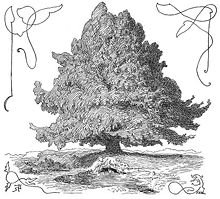Ask and Embla: the first two humans in Norse mythology
Known in Norse mythology as the progenitors of all humanity, Ask and Embla, male and female respectively, were said to have been created by the Norse gods. However, there are variations in the Norse creation story. In one account, the first two humans were created molded by the dwarfs and later given the breath of life and other gifts by Odin and his brothers Villi and Ve.
The article below explores everything that you need to know about how the first two humans in Old Norse literature.
Ask and Embla: the father and mother of the human species

A depiction of Odin and his brothers creating Ask and Embla | Image by Robert Engels (1919)
Meaning of Ask: “ash tree”
Meaning of Embla: “elm tree” Or “vine” Or “busy woman”
Other names: Progenitors of all humanity; the first human father and mother
Norse sources: Poetic Edda (a 13th-century compilation of Norse myths and stories), and Prose Edda – written by Icelandic poet Snorri Sturlusson
Origin story: Who created Ask and Embla?
Long before the first humans were created, the all-father god Odin and his brothers – Vili and Vé – trapped the first frost giant Ymir and killed him. Using the bones of Ymir, the three brothers made the earth. They used the remaining body parts of the giant to create things such as sky, mountains and the sea.
While walking in the woods, Odin and his brothers came across two tree trunks. Some accounts state that the deities found the tree trunks on the beach. In any case, the three brothers carved the first humans out of the tree trunks, giving them a male and a female shape. However, their creations lacked the basic features that made them humans. So the gods set out to bestow a number of gifts upon their creations, including the breath of life, movement, intelligence, speech, shape, and sight. Odin and his brothers also gave the humans names and clothes to keep them warm. The gods then made a home on Midgard (Earth) for Ask and Embla, commanding them to procreate and populate the world.
In an account from the Gylfaginning (also known as ‘The Beguiling of Gylfi’ or ‘The Deluding of Gylfi’) – the first part of the Prose Edda – Odin was in the company of his brothers Vili and Vé .

The all-father god Odin is said to have breathed into the first two humans the breath of life; while his brothers – Vili and Vé – gave Ask and Embla intelligence and the five human senses.
Account from the poem Völuspá
In the poem Völuspá in the Poetic Edda, a seeress (völva), narrates the Norse creation story. In this story, Odin is rather in the company of two obscure figures – Hœnir and Lóðurr – when they meet two very primitive, shapeless and powerless creatures who are without any discernible human senses.
Odin and his associates then take pity on the creatures and make them more refined by giving them many of the senses humans have today. Odin gave the first two humans soul, Hœnir gave them intelligence, and Lóðurr gave them goodly color. After bestowing those gifts upon the humans, the gods named them Ask and Embla, the first male and female respectively.

Ask and Embla creation story | According to the seeress (völva), Odin and his associates took pity on the first humans and bestowed upon them three gifts: a soul, sense, and goodly color.
Other facts about Ask and Embla

- Much of what we know about the first humans in Norse mythology are found in two major texts: the Prose Edda and the Poetic Edda. The latter is a 13th-century compilation of Norse myths and traditional stories; while the Prose Edda was authored by Icelandic lawmaker and poet Snorri Sturlusson (1178-1241). The Prose Edda tells of the creation and destruction of the world of the gods, including how the world and first humans were created.
- Ancient myths were very fascinated with explaining the origins of humans. Similar to accounts in Norse mythology, other ancient myths often proposed that humans were formed from trees. Take the example of the ancient Persians who believed that the first humans – Meshia and Meshiane – emerged from trees.
- The story of Ask and Embla is often associated with vines, which in turn was connected to fire and procreation. It was not uncommon for Proto-Indo-European tribes to use vines as a flammable wood, i.e. for drilling of fire. The vine represented Embla (female) while the drill used to light the vine represented Ask (male).
- Similar to Norse creation story, other cultures around the world have often placed the tree at the center of creation. Other times, rocks, bones and the teeth of mythical creatures were used to explain the origins of the entire human species.
- In the poem Völuspá in the Poetic Edda, the creation story of humans comes after the earth was formed and dwarfs came to being. This has led many mythologists to theorize that the dwarfs in Norse mythology were the ones who created humans before the gods gave breathed into them the breath of life.
- Due to their origin story, some scholars have referred to the first man and woman in Norse mythology as the “trees of battle” and “trees of jewelry” respectively.



























